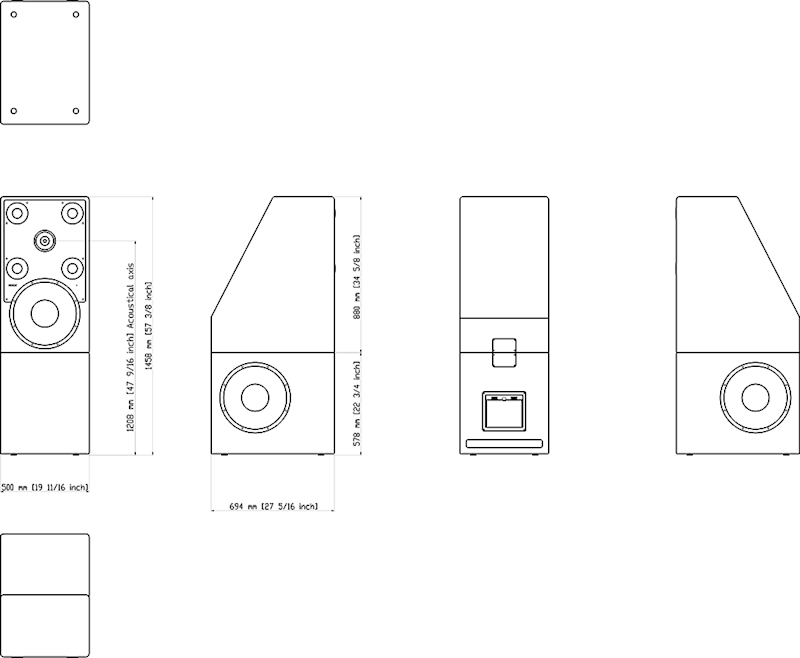Our 8381A empowers engineers and creators to perceive every sonic detail, offering true-to-life sound level and dynamics – with the full flexibility of free-standing monitor placement and advanced room adaption.


Our 8381A empowers engineers and creators to perceive every sonic detail, offering true-to-life sound level and dynamics – with the full flexibility of free-standing monitor placement and advanced room adaption.



Point Source Continued Directivity (PCD) Technology

Minimum Diffraction Coaxial (MDC™) Driver Technology

SPL
126 dB

Frequency Response
20 Hz - 35 kHz (-6 dB)

Dimensions
H 1458 x W 500 x D 694 mm, (view in inches)
Interacting with our Genelec Loudspeaker Manager (GLM) software, the 8381A monitor system intelligently adapts its response to the monitoring room in the optimal way. This offers great flexibility to tackle even the most challenging environments – delivering precise presentation, including low frequency reproduction that integrates perfectly with the complete sound content.
The 8381A has been engineered to deliver the complete audible content, with a response extending to frequencies beyond the standard audible range – and fully aligned in the time domain – it delivers precise understanding of all the minute details in recorded waveforms. With its high SPL capacity, the 8381A is able to make even very low-level details audible, making it an uncompromising tool for monitoring.
Quickly arrive at the right mixing and mastering decisions through uncompromising imaging detail. The point source operating principle of the 8381A offers the unique advantage of maintaining precise sound colour and imaging at all listening distances, enabling exceptional freedom of placement, and removing the vertical sound colour change typical of larger monitors.
The carefully designed Directivity Control Waveguide ensures clean off-axis sound colour, reducing the impact of the reverberant sound in the monitoring room on mixing decisions, while improving the accuracy and reliability of monitoring work in all rooms.
Standing on the floor, the 8381 locates the soundstage at the natural listening height, while supporting traditional high main monitor positions with the included incliner system. This enables the acoustic axis to be optimally configured towards the listening position for all installation heights.
The innovations of the 8381A push the limits of free-standing monitoring solutions, creating a powerhouse that deeply envelops the listener in flawless, true-to-life sound images.
The monitor excels at revealing the finest details of audio by combining immense, controlled power with pinpoint imaging precision, even in challenging monitoring spaces.
The point source design principle combined with optimised directivity control maintains the frequency balance in off-axis positions, supporting correct understanding of the sound colour when moving, standing or sitting in the monitoring room.
Crafted with expert guidance from celebrated Industrial Designer Harri Koskinen, the 8381A is completely designed and built in Iisalmi, Finland. Drawing on more than four decades of company experience, Genelec's passionate engineering team meticulously designed and optimised every component of the 8381A. In doing so, we've created a monitoring loudspeaker that's ideal for the audio world's most demanding applications – built to perform with effortless power and zero sonic compromise.
The 8381A powers a lifetime of creativity, so it comes included with access to our unique Genelec SonicAdvisor™ services. So, if you require any support on your monitoring journey with the 8381A – from initial configuration to on-site consultation – we're ready to help.
Genelec 8381A Adaptive Point Source Main Monitor has been chosen by Sound on Sound Magazine’s knowledgeable readership of audio professionals and enthusiasts as the winner of this year’s highly coveted SOS Best Studio Monitor Award.
Since 2010, Sound on Sound has sought the opinions of their huge worldwide following to decide the winners of a now iconic series of SOS Awards. Each year, the Awards' open online vote highlights the very finest new professional audio devices and software – helping audio lovers everywhere identify the year's best designs and innovations.
The 8381A Adaptive Point Source Main Smart Active Monitor is the recipient of a Technical Excellence & Creativity (TEC) Award at the 39th Annual TEC Awards, held on Saturday, January 27, at The 2024 NAMM Show in Anaheim, California. The 8381A got top honors in the Studio Monitors category. Finalists from all categories were selected by industry professionals across major music, sound, and game audio associations, along with pro audio focused media groups.
Presented annually by NAMM, the TEC Awards recognizes the individuals, companies and technical innovations behind the sound of recordings, live performances, films, television, video games and multimedia. Now in its 39th year, the Awards are widely recognized as the highest honor dedicated to the pro audio and sound recording industry.

126 dB

2 X 5926 W Full range (Class D)

20 Hz - 35 kHz ("-6 dB")

± 1.5 dB

2 x ⌀ 381 mm Bass + ⌀ 381 mm Bass + 4 x ⌀ 127 mm Midrange + ⌀ 127 mm Coaxial Midrange + ⌀ 25 mm Coaxial Tweeter (view in inches)

H 1458 x W 500 x D 694 mm, (view in inches)

235 kg / 518.1 lb

2 x XLR Analog Input
2 x XLR Analog Output
2 x XLR AES/EBU Input
2 x XLR AES/EBU Output
4 x RJ45 Control
Our 8381A empowers engineers and creators to perceive every sonic detail, offering true-to-life sound level and dynamics – with the full flexibility of free-standing monitor placement and advanced room adaption.



(± 1.5 dB)
Low cutoff -6dB
20 Hz
High cutoff -6dB
35 kHz
Peak SPL Maximum output per pair.
≥129 dB
Short term max SPL Mean SPL in range 100 Hz - 3 kHz,
≥126 dB
THD < 10 % f < 200 Hz, THD < 3 % f > 200 Hz
Short term sine wave, at 1 m, on axis, in half-space.
Long term max SPL Maximum long term RMS acoustic output, IEC-weighted noise (limited by protection circuit) at 1 m, half-space.
≥121 dB
Height
1458 mm
Width
500 mm
Depth
694 mm
Enclosure 1 dimensions: 880 x 694 x 500 mm Enclosure 2 dimensions: 570 x 694 x 500 mm Packing dimensions: 1076 x 1200 x 1000 mm
Enclosure material
MDF
Driver type
Cone
Double Low Woofers
Count
2
Diameter
381 mm
Driver type
Cone
Front Woofer
Diameter
381 mm
Driver type
Dome
Quad Midrange System
Count
4
Diameter
127 mm
Driver type
Cone
Coaxial Midrange
Diameter
127 mm
Driver type
Dome
Compression tweeter voice coil 25 mm (1 in), throat 13 mm (0.5 in)
Diameter
25 mm
2 x 5926 W Class D
2 X Class D amplifiers.
19 in rack mount, 3U high. Each amplifier is uniquely calibrated to a cabinet at Genelec factory in Iisalmi.
Total amplifier power is 5926 W.
Weight
11 kg
(24.3 lb)
100-240 VAC 50/60Hz
ISS Active
≤1.2 W
Idle
≤140 W
Full output
2200 W
2 x Input Analog signal input connector XLR female, balanced 10 kOhm.
2 x Output XLR output connectors, 10 kOhm.
2 x Input Digital signal input connector XLR female 110 Ohm.
2 x Output Digital signal output / Thru connector XLR male 110 Ohm.
4 x Control Four CAT5 (RJ45) GLM Network connectors for computer control using the Genelec Loudspeaker Manager (GLM) software.
Lower Woofer/Front Woofer
50-100 Hz (variable)
Front Woofer/Quad Midrange System
150-250 Hz (variable)
Quad Midrange System/Coaxial Midrange
500 Hz
Coaxial Midrange/Tweeter
1800 Hz
Point Source Continued Directivity (PCD) Technology

Minimum Diffraction Coaxial (MDC™) Driver Technology
Quad Midrange System (QMS)
Double Low-Woofer (DLW) System

Smart Active Monitoring (SAM™) and GLM™ calibration technology

Reflex Port Design

Intelligent Signal Sensing (ISS™) Technology

Directivity Control Waveguide (DCW™) Technology

Optimised Amplifiers

Protection Circuitry

Active Crossovers
Important frequencies are experienced radiating from the same location and in perfect time alignment – creating precise sound imaging, natural soundstage presentation, and enabling the lowest frequencies to be reproduced at their intended source locations.

Typical coaxial designs suffer from a somewhat ragged frequency response due to diffraction problems inherent in their unrefined design. However, crossover issues due to the non-coincident location of sources are solved with a coaxial configuration, so a coaxial solution without diffraction problems is the ideal. Genelec’s Minimum Diffraction Coaxial (MDC™) Driver Technology provides all the benefits of coaxial design while overcoming the typical shortages – solving the diffraction problem.
The first step is to minimise the cone displacement, in other words to limit the low frequency bandwidth of the driver. Next, is to avoid all sources of diffractions. The main structure of the MDC design consists of an integrated MF diaphragm-suspension tweeter construction. The visible part of the coaxial driver is formed by the curved flexible skin with the dome tweeter assembly in its centre. The inner section joins the cone to the tweeter without any acoustical discontinuity, and the outer one does the same between the cone and the driver chassis.

As there are no acoustically observable discontinuities between the tweeter and the cone, just a smooth surface, there is no diffraction either. The cone profile is very carefully optimised to form an integrated directivity control waveguide for the tweeter radiation. The driver outer edge is terminated to a normal Genelec DCW in order to control the dispersion of midrange radiation as well. The response is very smooth both on and off-axis and free from any anomalies – and directivity is well controlled.
This breakthrough in coaxial design provides improved imaging and overall sound quality on and off-axis, extremely smooth frequency response leading to outstanding clarity and definition of the inner details of the music.

Acoustically coaxial woofer solution to support Minimum Diffraction Coaxial (MDC) driver output and maintain directivity in lower frequencies, enabling point source characteristics down into the woofer range.
Recoil-compensated adaptive low-woofer solution that combines with our Point Source Continued Directivity (PCD) Technology to give complete freedom of monitor placement in the room – with no compromise in performance or imaging detail.

Now, more than ever, audio productions are engineered in tighter, more confined working environments. This increases acoustic problems and lowers the reliability of monitoring. At the same time, an audio engineer's need to trust a reliable and precise monitoring system that reproduces sound neutrally and without distortion has not changed.
Built upon the solid electro-acoustic foundations of our 1200, 8000 and 7000 Series products, Genelec SAM Systems are today’s most advanced and flexible monitoring solutions. They are an indispensable tool for audio professionals, as they automatically adapt to the acoustic environment and correct for level, delay and room anomalies. SAM Systems are controlled using Genelec's proprietary Loudspeaker Manager (GLM™) network and software, enabling you to build a highly flexible and reliable monitoring system.
GLM is a highly intuitive and powerful monitor control networking system that manages connectivity to all SAM studio monitors and subwoofers on the network. GLM software features adjustment of level, distance delay and flexible room response compensation equalisation with our state-of-the-art, highly robust AutoCal™ 2 algorithm automated calibration system. All parameters and settings are stored in system setup files or saved in each individual monitor or subwoofer, if the GLM network needs to be disconnected.
Also, all acoustical features of SAM Systems can be optimised and tailored for different working styles or client demands. Additionally, even if the monitors or the production projects move between rooms, you can expect SAM technology to provide the highest consistency in monitoring, providing neutral soundstage imaging with low distortion – in each environment.
Genelec SAM Systems offer a comprehensive, solution-oriented, intelligently networked product range supporting analogue and digital signals in virtually any working environment.

Genelec’s choice for vented, or reflex, enclosures dates back to the S30 model, the first Genelec product from 1978. Port performance has been improved and refined over the years with the aim to increase the woofer’s low frequency extension and sound pressure level capability to provide outstanding bass articulation and definition.
Both driver and vent contribute to the total radiation of a reflex enclosure. Most radiation comes from the driver, but at the vent-enclosure resonant frequency the driver displacement amplitude is small and most of the radiation comes out of the vent.
To minimise the air speed in the tube, the cross sectional area of the vent should be large. This in turn means that the vent tube has to be long which presents quite a design challenge.
The long, curved tube maximises airflow so deep bass can be reproduced without compression. The reflex tube terminates with a wide flare located on the rear of the enclosure, minimising port noises and providing excellent bass articulation.
The curvature of the tube has also been carefully designed to minimise any audible noise, compression or distortion. The inner end of the tube has proper resistive termination to minimise once again audible chuffing noise and air turbulence.
Proper reflex port design allows also to significantly reduce the woofer’s displacement, improving the linear low frequency output capacity.

Introduced early 2013, Genelec’s Intelligent Signal-Sensing technology has been developed to meet with both European Union ErP Directives and Genelec's own ambitious sustainability standards.
The Intelligent Signal Sensing, ISS™ circuitry tracks the signal input of the loudspeaker and detects if it is in use. If the ISS circuit does not find any audio on the input for a period of time, it sets the loudspeaker to a low-power sleep state and the loudspeaker will consume less than 0.5 watts. When an input signal is detected, the loudspeaker immediately turns itself on.
Additionally an ‘ISS Disable’ switch is located on each product’s back plate next to the other room response controls. First, when the mains power switch of the loudspeaker is set to 'ON', the ISS™ auto-start function (low-power sleep state on/off) of the loudspeaker is active.

If this function is not desired, the ISS™ function can be disabled by setting the 'ISS Disable' switch on the back panel to 'ON' position. In this mode, the monitor is only powered on and off using the mains power switch.
Note that the mains power switch will always turn the monitor off completely.

A revolutionary approach was taken by Genelec in 1983 with the development of its Directivity Control Waveguide (DCW™). We have developed and refined this technology over more than 30 years to greatly improve the performance of direct radiating multi-way monitors.
The DCW technology shapes the emitted wavefront in a controlled way, allowing predictable tailoring of the directivity (dispersion) pattern. To make the directivity uniform and smooth, the goal is to limit the radiation angle so that the stray radiation is reduced. It results in excellent flatness of the overall frequency response as well as uniform power response. This minimises early reflections and provides a wide and controlled listening area achieving accurate sound reproduction on and off-axis.
Minimised early reflections and controlled, constant directivity have another important advantage: the frequency balance of the room reverberation field is essentially the same as the direct field from the monitors. As a consequence, the monitoring system's performance is less dependent on room acoustic characteristics.
Sound image width and depth, critical components in any listening environment, are important not only for on-axis listening, but also off-axis. This accommodates not only the engineer doing their job, but also others in the listening field, as is so often the case in large control rooms.

Audio electronic crossovers allow to split the audio signal into separate frequency bands that can be separately routed to individual power amplifiers, which are then connected to specific transducers optimised for a particular frequency band.
In a typical 2-way loudspeaker system, the active crossover needs two power amplifiers — one for the woofer and one for the tweeter. The power amplifiers are connected directly to the drivers of an active loudspeaker, resulting in the power amplifier’s load becoming much simpler and well known. Each driver-specific power amplifier has only a limited frequency range to amplify (the power amplifier is placed after the active crossover) and this adds to the ease of design.

When working in critical audio production environments it is essential that monitoring systems remain reliable and functional at all times. One of the main reasons behind Genelec’s excellent success in broadcasting environments is the reliability of our products and a key element behind the reliability is the internal protection circuitry found in all products since 1978.
The protection circuitry prevents driver failures by detecting signal levels, and in case of sudden peaks or constantly too high levels, taking the signal level down automatically. Of course this feature does not affect the sound quality in any way when working within the specifications of the loudspeaker, but only prevents inadequate input signals from breaking the loudspeaker.


Audio electronic crossovers allow the audio signal to be split into separate frequency bands that are separately routed to individual power amplifiers, which are then connected to specific transducers optimised for a particular frequency band.
Active crossovers come in both digital and analogue varieties. Genelec digital active crossovers include additional signal processing, such as driver protection, delay, and equalisation.
Genelec analogue active crossover filters contain electronic components that are operated at low signal levels suitable for power amplifier inputs. This is in contrast to passive crossovers that operate at the high signal levels of the power amplifier's outputs, having to handle high currents and, in some cases, high voltages.
In a typical two-way system the active crossover needs two power amplifiers — one for the woofer and one for the tweeter.
Using the active approach enables frequency response adjustments and optimisation of the full loudspeaker system, placed in various room environments, without expensive external equalisers. The end result is a simpler, more reliable, efficient, consistent and precise active loudspeaker system.
A quick guide to our UNIO Ecosystem – which offers audio engineers seamless bridging of in-room and personal headphone monitoring. https://genelec.com/UNIO
The Genelec UNIO Ecosystem – which combines the power of our renowned GLM, SAM Monitoring and Aural ID adaptive technologies – gives audio engineers the flexibility to work anywhere, anytime, from stereo to immersive. And now, with the new UNIO Personal Reference Monitoring (PRM) solution, audio professionals benefit from the pinpoint accuracy of our pioneering active monitoring headphone solution, which combines the 9320A SAM Reference Controller with uniquely factory-calibrated 8550A Professional Reference Headphones.
To learn more, visit https://genelec.com/UNIO
Liberate the way you listen in your space with immaculate imaging both on and off-axis, near or far, thanks to point source characteristics that extend below midrange and advanced room adaption from our Smart Active Monitoring (SAM) Technology and Genelec Loudspeaker Manager (GLM) software.
Keep all the benefits of free-standing monitor placement, for a simple, zero-hassle installation. The 8381A is main monitoring as you’ve never known it before. Ideal for high sound pressure level applications in medium to large control rooms in professional recording, mixing and mastering studios, and for the most demanding high-fidelity listening applications.
Perceive every sonic detail with the new Genelec 8381A Adaptive Point Source Main Monitor, offering true-to-life sound level and dynamics and an ultra-wide full-range response. Liberate the way you listen in your space with immaculate imaging both on and off-axis, near or far, thanks to point source characteristics that extend below midrange and advanced room adaption from our Smart Active Monitoring (SAM) Technology and Genelec Loudspeaker Manager (GLM) software.
hello
You can also submit an enquiry to our customer support team here.









